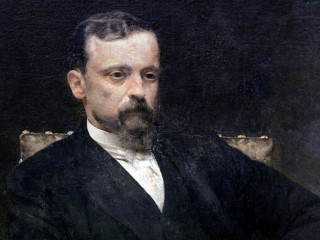
Henryk Sienkiewicz biography
Date of birth : 1846-05-04
Date of death : 1916-11-14
Birthplace : Wola Okrzejska, Congress Poland
Nationality : Polish
Category : Arts and Entertainment
Last modified : 2011-06-07
Credited as : Novelist ad journalist, Quo Vadis?, Nobel Prize-winning novelist
Born on May 4, 1846, in Wola Okrzejska in Russian-occupied Poland, Henryk Sienkiewicz enjoyed a peaceful childhood in the country, encountering the conflicts of his divided land only when his family moved to Warsaw and the boy began secondary school. An average student, Sienkiewicz graduated to a post as tutor in a wealthy family before returning to Warsaw University; there he hesitated between medicine and law, finally transferring to the faculty of history and literature. He left the university in 1871 without taking his examinations. During the next 5 years Sienkiewicz painfully established himself as a free-lance writer and journalist. He distinguished himself as a chronicle writer, a popular reporting genre that took him to Vienna, Ostend, and Paris; his regular feuilletons contained charming, entertaining episodes of daily life as well as serious treatments of pressing social issues. In 1876 the successful journalist was sent to the United States, and Sienkiewicz sent back from America a collection of short stories (Charcoal Sketches) and material for his American Letters.
Returning to Europe in 1878, Sienkiewicz lived for a time in Paris and Italy, writing short stories ("Orso," "Yanko the Musician," "From the Memoirs of a Poznan Tutor," and "After Bread") and lecturing on his American experiences. His marriage to Maria Szetkiewicz in 1881 marked the beginning of the most contented and richly productive period of his life. Appointed editor of a new Warsaw daily, he continued writing chronicles and short stories. Concerned with the oppressed peasantry, he wrote tragic narratives of a divided people that were occasionally censured, and even such American tales as "Sachem" and "The Lighthouse Keeper" revealed his deep national feeling.
These years witnessed as well the most important transformation in Sienkiewicz's artistic career: his turning away from journalism and the short narrative to embark upon the creation of epic tableaux from Poland's national past. From 1882 to 1887 his trilogy appeared, first as a serial, then with even greater success in book form. Recreating the 17th-century struggle for existence of the Polish-Lithuanian commonwealth, With Fire and the Sword, The Deluge, and Pan Michael traced a people's heroic resistance to invasion by the Cossacks and the Swedes. Sienkiewicz's purpose was to revive national sentiment with a vision of ancestral vigor. He gained overwhelming public approval for his encouraging evocation of a glorious past.
Sienkiewicz next turned to a contemporary setting, offering a lengthy diagnosis of the Polish upper-class findesiecle malaise in Without Dogma (1890); its somewhat morbid hero was sharply contrasted with the progressive and robust characters of Children of the Soil (1894). In 1893 Sienkiewicz began work on his best-known historical novel, Quo Vadis? Its story of early Christian persecution paralleled the political upheavals Sienkiewicz had traced for Poland in his trilogy. This novel is considered a stylistic masterpiece, and it remained for many years the most successful fictional publication in history. Sienkiewicz gained international celebrity with Quo Vadis?, but his patriotic sense of a distinct national past led him to turn next to Poland's dark ages, with The Teutonic Knights (1900), tales of rapacious foreigners and of long-suffering Poles.
Sienkiewicz enjoyed a jubilee celebration in his honor in 1900, and he was at the height of personal fame when he received the Nobel Prize for literature in 1905. His remaining work showed a decline in conceptual strength. On the Field of Glory (1905) returned to the era of the trilogy, but with less success. In Desert and Wilderness (1911) was a children's story reminiscent of Rudyard Kipling and Daniel Defoe, rich in a positivistic didacticism then out of date. Sienkiewicz's last important work, Whirlpools (1910), reflected alarm at the outbreaks of revolutionary activity in Russia, that "storm from the East" threatening to "cover our tradition, civilization, culture—the whole Poland and turn it into a desert."
World War I drove Sienkiewicz into exile in Switzerland, where he directed Polish relief work and where he died on Nov. 14, 1916.
















